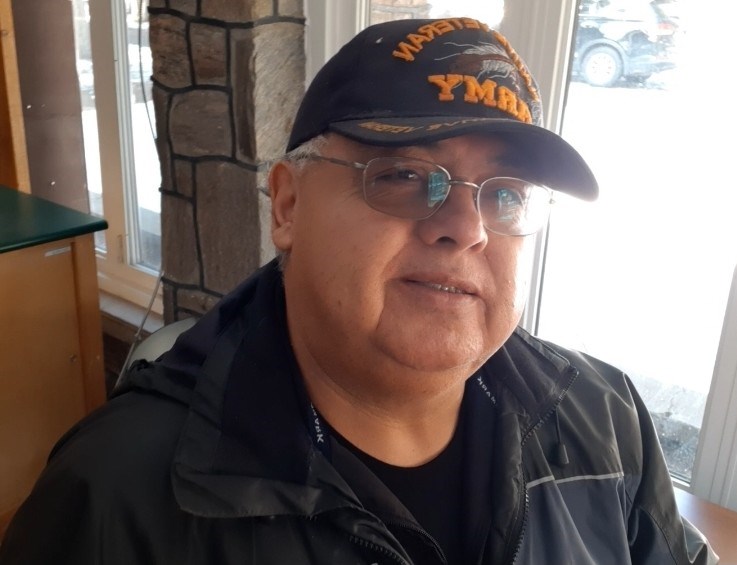Giiyaabi maa Iyawmin. We are still here.
It is possible to become a missing person in Simcoe County. It’s even possible to be of a group of missing peoples in Simcoe County. Let me tell you what I mean.
The Anishinaabeg (Ah-nish-ih-naw-behg) were always here on this land since time immemorial.
However, archaeological excavations in Simcoe County carried out in the late 1800s and early 1900s by Andrew F. Hunter, seemed to eliminate the Anishinaabeg. Mr. Hunter, a Christian, and the editor of the Barrie Examiner, concentrated on the history of the French Jesuits, the Wendaat, and the birthplace of Christianity in the New World.
Andrew F. Hunter, the archaeologist/newspaper editor, created a story not about how First Nations lived in harmony on this land, but of how the French Jesuits and the Wendaat created a partnership in this so-called New World.
That narrative eliminated the Anishinaabeg from the written historical account. It seemed that in that rendition of local history we became “holey” ghosts. So “holey” that everyone looked right past and through us to concentrate on creating the utopic village known as Ste. Marie among the Hurons.
But we were still here.
In a census recorded by the Jesuits during that time period, it was estimated that there were as many as 50,000 Indigenous people in this area alone. That included other First Nations besides the Wendaat. I’ve often wondered why the Jesuits would have broken the Cardinal rule, “Never count your souls before they are converted.” But, I digress.
We hunted, fished, gathered medicines and feasted on the bounty bestowed upon us by the Creator. We shared the land and lived in harmony with other Nations. The Betan (Petun), Kanien'kehá:ka (Mohawk), Wendaat (Huron), all lived in harmony while occupying this territory. Our oral history speaks of those relationships.
Recent archaeological excavations, and the resulting archaeological reports, seem to validate the story which had been told by Indigenous people and passed on over time. It runs counter to the narrative that two or more Indigenous Nations could not co-exist within each other's territory.
It runs counter to the European historical view of the savage bloodthirsty Indians cannibalizing and being constantly at war with each other. I have never salivated at the sight of another Indigenous person from another First Nation. If I drool at all it’s due to this ill-fitting dental work. But again, I digress.
In the 1980s, two excavations in Ontario hypothesized that evidence obtained from a site near Barrie (Molson site) and another near London showed that the occupants within Wendaat villages included campfires from other First Nations. These findings support the oral history of the Anishinaabeg which told of how we routinely visited one another.
In our teachings, the Crane clan were the exterior chiefs and they were the ambassadors for our nation. One of their roles was to carry the Waampams (Wawm-pums), which depicted our treaty relationship with other Indigenous Nations.
They would often visit other nations to procure and maintain peaceful relations with one another. The protocol was that anyone carrying waampam was to be left unharmed and welcomed into a territory to honour those Treaties with truth.
Those agreements were said to have been made through sacred oath as part of the ceremony to that partnership. It seems that the Anishinaabeg fascination with beads and trinkets goes back a long way.
The basic teaching for all human beings the world over is that we are to be kind to one another and that teaching shows up time and again in our oral history. It was bred into us. It became a part of our culture.
In the last Waampam/Treaty of 1701, a peace treaty between the Anishinaabeg and the Kanien'kehá:ka, we agreed to once again share in the bounty of the territory (One Dish, One Spoon) as partners.
The partnership had been severed by what we called the “Great Imbalance,” also known as the fur trade. It was a time when Europeans attempted to monopolize a trade (furs). This (monopoly) was something that had never before occurred within our territory by any Indigenous Nation. It caused us to wonder “who are these furries?”
The record of that relationship had once been depicted in the stone at Mnjikaning, the Fish Fence, which has been in the water for over 10,000 years at the Narrows near Orillia. That was before the stone disappeared. It was chipped away and removed piece by piece until finally, few remember that it ever existed. It vanished like a part of history not considered important enough to be part of the official record.
I, and other Anishinaabeg, know the feeling far too well.
Jeff Monague is a former Chief of the Beausoleil First Nation on Christian Island, former Treaty Research Director with the Anishnabek (Union of Ontario Indians), and veteran of the Canadian Forces. Monague, who taught the Ojibwe language with the Simcoe County District School Board and Georgian College, is currently the Superintendent of Springwater Provincial Park. His column appears every other Monday.



